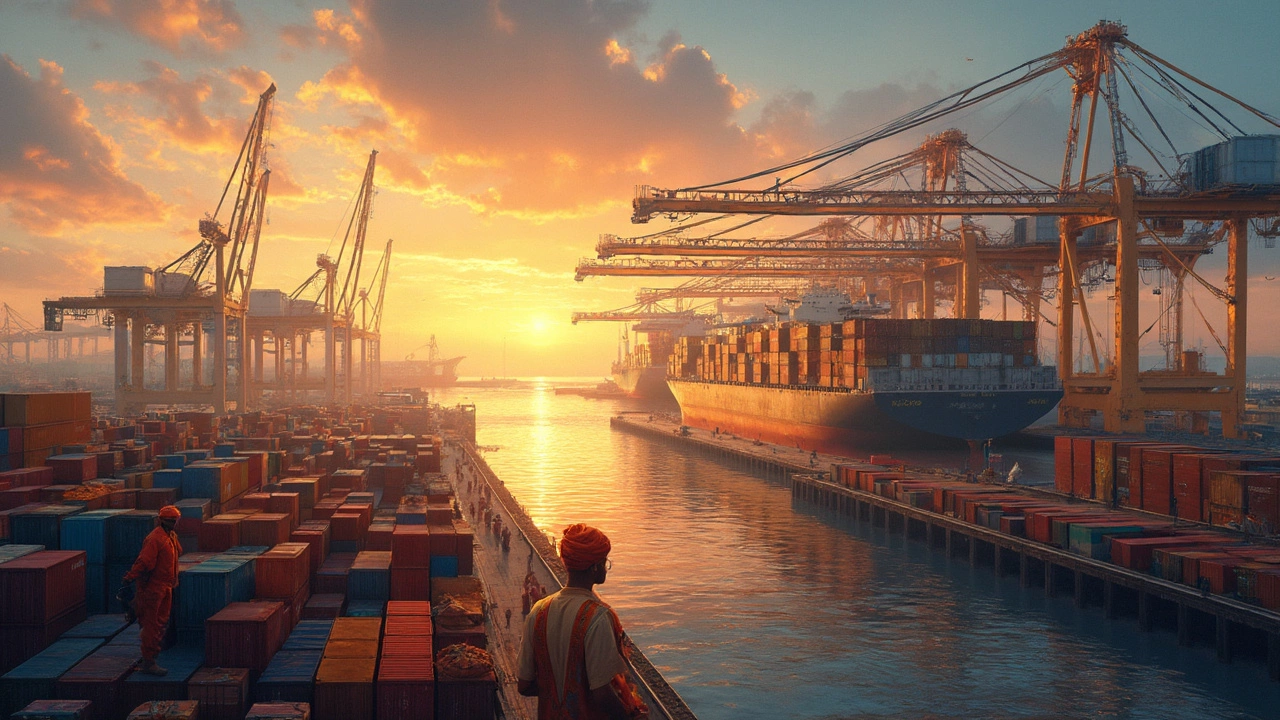
If you think of India’s biggest trade, you probably picture something like tech or textiles. But here’s a curveball: petroleum products are actually at the top of India’s export list. Yep, it sounds a bit odd, considering India imports a ton of crude oil. But what really happens is that the country refines it with some serious tech muscle, then re-exports fuel, diesel, and petro-derivatives to other countries—especially in Asia and Africa.
This isn’t just about oil, though. India’s massive shipments of jewelry and precious stones, mostly diamonds, take a close second spot. Furniture and tea? Far behind. These two—petroleum and gems—make up about a quarter of all India’s export value. If you’re asking yourself if this field has room for growth or jobs, you’re thinking smart. India’s evolving global trade brings a rush of opportunities, from logistics to sales and import-export management, and the demand for skilled pros in these sectors keeps rising.
- India’s #1 Export: More Than You Think
- Top Imports: What India Brings In
- How These Trades Shape Jobs and Courses
- Surprising Facts About India’s Trade
- Tips for Getting Into the Trade Sector
India’s #1 Export: More Than You Think
When people talk about India's biggest export, most guess IT or textiles first. Here’s the real answer: processed petroleum products, like fuels and diesel, actually top the India trade charts year after year. As of 2024, refined petroleum makes up around 17% of the country's total export value. Even with India importing about 80% of its crude oil, it’s the refining industry that turns that massive import bill into a winning export number.
Some of the largest refineries in Asia sit on Indian soil, with Reliance Industries’ Jamnagar complex often called the biggest in the world. This isn’t just good for company profits—it creates solid job opportunities in refining, quality control, logistics, and shipping. Companies export diesel, gasoline, and even jet fuel, sending them to places like Singapore, UAE, and the Netherlands.
To put it in perspective, in the last fiscal year, India exported petroleum products valued at over $85 billion. This export machine runs alongside another powerhouse: gems and jewelry. Together, these two sectors handily beat software and pharma if you’re just counting dollars.
It’s important to recognize how strong these sectors are when considering a career in trade. Skills in supply chain management, compliance, quality assurance, or trading can open doors. Plus, if you get into training or courses focused on international trade or oil & gas, you’re plugging right into India’s biggest export industries. Think real-world learning that actually sees major action, both locally and across the globe.
Top Imports: What India Brings In
When it comes to what India buys from the world, a few things stand out right away. Topping the list: crude oil. It’s not even close. India runs on imported oil, and around 85% of the country’s oil needs are filled by imports. The Middle East is India’s main supplier, but places like Russia have climbed up the charts recently, especially with discount deals over the past couple of years.
After oil, there’s gold. Not for bars in banks—this is for jewelry. India’s connection with gold isn’t just about tradition. It’s big business, feeding the country’s giant gold market and wedding season every year. Electronics come next. Phones, laptops, and almost any gadget you can name—most are made outside India and shipped in, mostly from China and Southeast Asia.
If you’re thinking food, you’re not wrong either. India does import edible oils, like palm oil and soybean oil, since local production can’t always keep up with the demand for cooking. And then there’s machinery, chemicals, and pharmaceutical raw materials—think ingredients for medicines, made abroad but formulated into final drugs in India’s pharma plants.
| Product | Share of Imports (2023) | Main Supplier Countries |
|---|---|---|
| Crude Oil | 32% | Saudi Arabia, Iraq, Russia |
| Gold | 8% | Switzerland, UAE, South Africa |
| Electronics | 15% | China, Vietnam, South Korea |
| Edible Oils | 5% | Indonesia, Malaysia, Argentina |
| Machinery | 9% | Germany, China, USA |
This pattern shapes what skills and courses are in demand. For anyone eyeing jobs or studies related to trade, knowing where India relies on imports helps a lot. Think logistics, international negotiations, sourcing, and customs clearance.
Focusing your training or career path around these core import sectors—oil, gold, electronics, or machinery—boosts your odds of finding work tied to big, steady trade volumes. The India trade scene depends heavily on reliable imports, so understanding these inside out is just smart planning.

How These Trades Shape Jobs and Courses
The crazy thing about India’s biggest trades is how much they shake up the job market. When you talk about India trade, you’re not just thinking of massive ships and big companies. These trade sectors open up actual jobs and push unis and institutes to design courses that fit today’s needs.
First up: petroleum exports. There’s solid demand for refinery techs, process engineers, and even international logistics pros. Think about Reliance Industries (Jamnnagar has the world’s largest oil refinery) — thousands work there, and people who study chemical engineering or logistics are gold for this sector.
Next, the gemstone and jewelry scene is a jobs magnet. Surat, Gujarat? That city alone cuts and polishes around 90% of all diamonds worldwide. So, there’s a serious need for gemologists, quality analysts, and even creative jewelry designers. Big names like Titan or Kalyan Jewellers hire both freshers and pros.
Things don’t stop at factories or showrooms, though. Import-export managers and customs professionals are in demand across sectors. Even banks and insurance firms have teams just for global transactions and risk management.
If you’re planning to skill up, here’s what’s hot in the market right now:
- Diploma in International Trade Management
- Post-graduate programs in Supply Chain and Logistics
- Courses in Customs, Shipping, and Freight Forwarding
- Short-term workshops (like EXIM training) for people switching careers
- Specialized gemology and jewelry design courses
Check out some stats that really show where the action is happening:
| Sector | Estimated Jobs (2024) | Popular Courses |
|---|---|---|
| Petroleum Refining & Exports | 200,000+ | Chemical Engineering, Export-Import Mgmt. |
| Gems & Jewelry | 5 million+ | Gemology, Jewelry Design, Quality Control |
| Logistics & Supply Chain | 2.3 million+ | Logistics Mgmt., Supply Chain Certification |
| Import-Export Services | 360,000+ | EXIM, Customs & International Trade |
Most of these fields offer clear ladders for growth. Newcomers can start as trainees (even after short, industry-led courses), and folks with a few years’ experience quickly jump up to roles in planning, compliance, or international sales. With e-commerce rising and ‘Make in India’ staying strong, jobs and trade courses are only going to get more important.
Surprising Facts About India’s Trade
It’s easy to assume India only exports spices, textiles, or software. The real story is more unexpected. For starters, India is the world’s largest exporter of polished diamonds. Surat, a city in Gujarat, actually handles almost 90% of the world’s diamond cutting and polishing work—so a diamond ring in the US or Europe likely started out in India.
Here’s another twist: India imports more gold than nearly any other country. We love gold so much that it’s the main import after crude oil. And that hunger for gold isn’t just for jewelry; it drives a huge part of the rural economy and even affects the country’s trade deficit.
Now, think tech. While everyone talks about IT exports, what doesn’t get enough attention is that India is also the second-largest exporter of pharmaceuticals—especially generic medicines. Indian-made meds fill up pharmacy shelves in Africa, the US, and even parts of Europe, thanks to strict quality checks and affordable pricing.
- A surprising side hustle is that India exports beef—mostly buffalo meat. Even though many within the country don’t consume beef, the export market for buffalo meat is huge, with Vietnam and Malaysia as regular buyers.
- On the import side, India brings in more electronics, especially smartphones and computers, than cars or luxury goods. Most major brands from China and South Korea depend on the Indian market for volume.
- A little-known fact: India is a massive importer of edible oil, like palm and soybean oil, mainly from Indonesia, Malaysia, and Argentina. Local production just can’t keep up with the demand, so trade in these products is booming.
All these unexpected details mean that India trade isn’t just about what you see in the markets. It runs deep, touches almost every industry, and creates plenty of quirky side stories you won’t find in a textbook.

Tips for Getting Into the Trade Sector
Breaking into India’s trade sector can feel a bit like joining a club with secret rules. But here’s the deal: you don’t need to have family in the business or tons of money. What you do need is some straight-up knowledge, practical skills, and a game plan.
It all starts with understanding the major players and the main routes—especially if you want to make an impact with India trade. Mumbai, Delhi, and Chennai are trade hotspots, and most of the big import-export firms run from these cities. Learning about customs, laws, and how to juggle international deals is a must. That's why there are dedicated courses—both short and long-term—tailored for trade enthusiasts. The Indian Institute of Foreign Trade (IIFT) and Indian Institute of Export Management (IIEM) are heavy hitters; their certificates can fast-track your resume to the right desk.
If you’re planning to pick a course, check its focus. Does it teach you paperwork, supply chain, foreign languages, and current regulations? All these bits matter because trade is about more than just knowing what to ship: it’s about the how, when, and where.
"Getting formal training helps you skip trial-and-error. Even a three-month course can connect you to the right people and open up jobs now that hiring is more skill-focused than ever," says Ramesh Shetty, senior faculty at IIFT.
There’s also a big push for digital in trade now. The Indian government’s Digital India push and e-commerce sites have made learning about shipping, tracking, and even online payments a must-have skill. Many firms look for freshers who can handle software like Tally or SAP, and who are comfortable with apps and online documentation portals.
Here's a quick look at some hot areas where jobs are growing fast:
- Logistics and supply chain management
- Export documentation and compliance
- International marketing and sales
- Customs clearance and freight forwarding
- Digital trade operations
And if you want hard numbers, check out this table based on the 2024 Ministry of Commerce job stats:
| Trade-Related Job Role | % Growth (2022-2024) |
|---|---|
| Logistics Manager | 28% |
| Export Documentation Analyst | 22% |
| International Sales Executive | 31% |
| Customs Compliance Specialist | 19% |
| Supply Chain Digital Coordinator | 37% |
One last tip: join trade forums or business groups. Sometimes, jobs or internships are shared first in Whatsapp and LinkedIn groups before they even reach job portals. If you’re open to moving, big ports like Mundra, Kandla, and Nhava Sheva have lots of entry-level roles that teach you more than any textbook.
